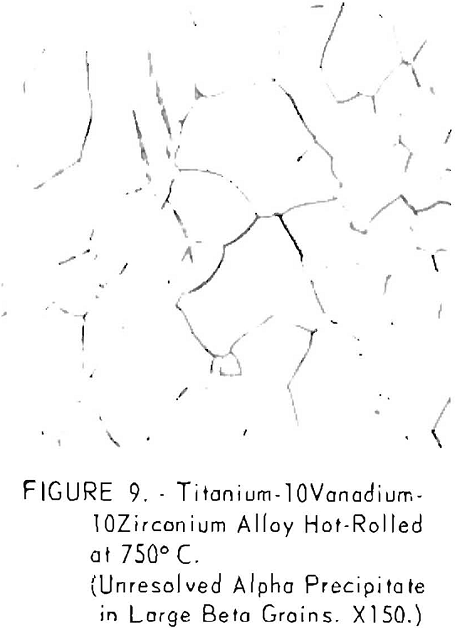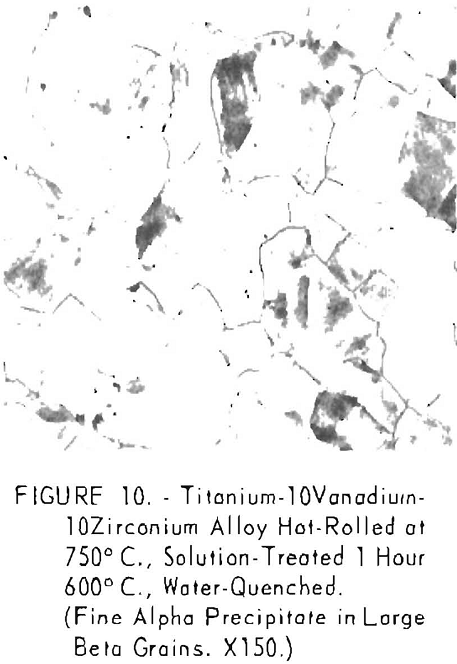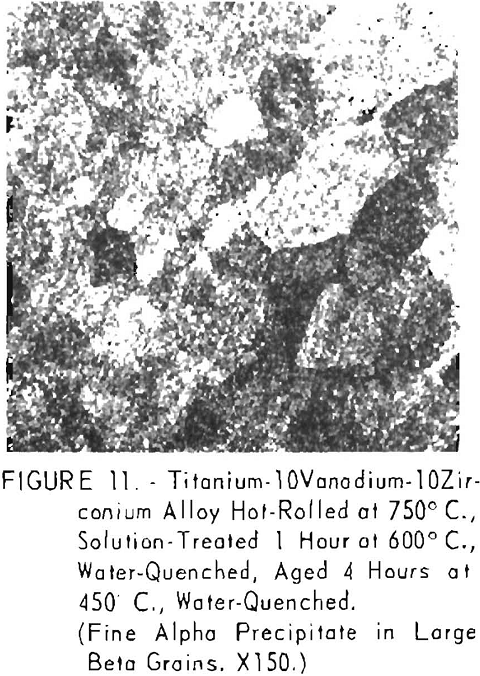A titanium alloy containing 10 a/o vanadium and 10 a/o zirconium has potential strength and heat treatability that merits further investigation. The titanium-10vanadium-10zirconium alloy, solution-treated at 600° C. is relatively sort, having a yield strength of 73,800 p.s.i. Aging 4 hours at 450° C. strengthens the alloy to a yield strength of 142,900 p.s.i. Ductility (3.1- percent elongation in 1 inch) is low, but adjustments in alloy content and working temperatures may improve this property.
In the composition range of 5 to 20 a/o vanadium and 5 to 30 a/o zirconium, zirconium strengthened the titanium alloys containing 5 and 10 a/o vanadium. The 15 a/o vanadium alloys were strengthened by the addition of 5 a/o zirconium, whereas 10 a/o zirconium lowered the strength slightly. The loss of strength was considerable for the titanium-20vanadium alloy containing 5 a/o zirconium.
Alloys having total vanadium plus zirconium content of 30 or more a/o were hot-short and oxidized readily when heated in air.
The objective of this investigation was to make a preliminary evaluation of titanium-vanadium-zirconium alloys using room-temperature tensile properties as criteria for selecting promising alloys for future critical studies.
Arc-melted titanium-vanadium-zirconium alloys ranging in composition from 5 to 20 a/o (atomic-percent) vanadium and 5 to 30 a/o zirconium, were investigated to evaluate hardness, hot workability, and room-temperature tensile properties. Metallographic examination coupled with hardness measurements were used to follow structural changes and aging response. Room-temperature tensile properties were criteria for evaluating mechanical and engineering properties of the alloys.
One alloy, titanium-10vanadium-10zirconium, was relatively soft in solution-treated condition with a yield strength of 73,800 p.s.i. Aging 4 hours at 450° C. strengthens the alloy to a yield strength of 142,900 p.s.i., but the ductility (3.1 percent elongation in 1 inch) was low. The alloys were hot-rolled at 750° C., solution-treated at 600° and 800° C., and aged from 15 minutes to 24 hours at 350°, 450°, and 500° C. Alloys having a total vanadium plus zirconium content of 30 a/o or more were hot-short and oxidized severely when heated in air.
Generally, zirconium strengthens solution-treated and aged titanium alloys containing 5 and 10 a/o vanadium. The 15 a/o vanadium alloys were strengthened by adding 5 a/o zirconium, whereas adding 10 a/o zirconium lowered the strength slightly. Considerable loss of strength was apparent for the titanium-20vanadium alloy containing 5 a/o zirconium.
The transformation characteristics and mechanical properties of titanium-vanadium alloys have been extensively investigated. It was found that the properties resulting from heat treatment depend upon quantity and composition of metastable beta retained by quenching and the amount and configuration of transformation products produced by aging,
E. T. Hayes and others, investigating the titanium-zirconium system reported that the metals are soluble in both the alpha and beta modifications. Maximum strengths were developed in the 50-a/o composition, but these alloys oxidized severely when heated in air at 1,000° F.
A. Nowikow and H. G. Baer have studied transformation in the ternary system and constructed an isothermal section at 750° C.
Materials and Experimental Procedures
Table 1 gives the chemical composition and source of metals used in the investigation. The high-purity, low-hardness titanium resulting from fused-salt electrorefining techniques contains only minor impurities and interstitial contaminants. Table 2 lists the calculated composition of experimental alloys prepared. Duplicate compacts of metal, weighing 80 grams each, were double-melted in a tungsten electrode furnace under helium into 2-inch-diameter buttons. Maximum weight loss during melting for all compositions was less than 2 percent, which is normal for unalloyed metal. The buttons were machined parallel on both sides to a thickness of 0.400 inch preparatory to hot-rolling and conditioned on emery paper before hardness determination. Rockwell C hardness (at least 6 tests) was determined for top and bottom of buttons to check homogeneity.
All alloys were hot-rolled at 750° C. to a thickness of 0.050 inch in 10-percent reductions. Total furnace time was 45 minutes. The highly coherent oxide coating was removed by light sandblasting.
Specimens for heat treatment were ½ by ½ by 0.050 inch. All treatments were conducted in a tube furnace under helium atmosphere purified by heated titanium turnings. The aging response of alloys that were satisfactorily hot-rolled was determined after solution treatments at 600° and 800° C. for 1 hour followed by water quenching. Samples were aged at 350°, 450°, and 500° C. for periods of 15 minutes to 24 hours. Hardness values were determined for each aging period.
Specimens for metallography were electrolytically polished in an electrolyte of the following composition: 590 cc. methyl alcohol, 350 cc. butyl cellusolve, and 60 cc. perchloric acid. A current density of 0.113 a./mm², applied for three successive periods of 10 seconds each, comprised the polishing cycle. The specimens were chemically etched in an aqueous solution containing 1.5 percent HF and 3.0 percent HNO3.
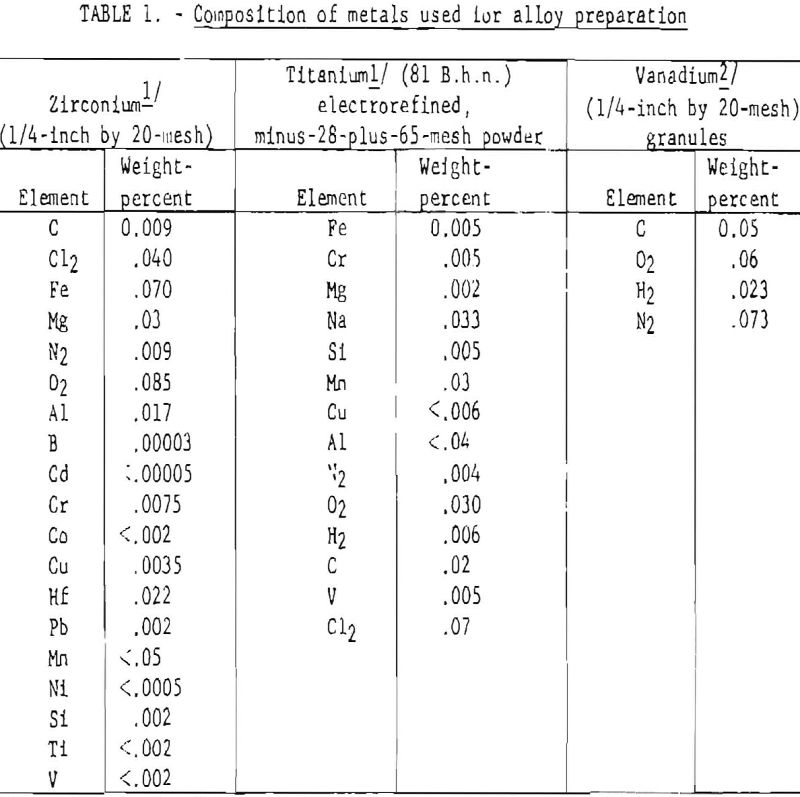

Room-temperature tensile properties were determined for the two solution temperatures after aging at 450° and 500° C. Tensile specimens with a 1-inch gage length and a width of ¼ inch were prepared with the long axis of the specimen parallel to the direction of rolling.
Results and Discussion
No unusual difficulty was observed in melting the titanium-vanadium-zirconium alloys. The limitation of arc-button melting lies mainly in the size and shape of ingots produced. The coarse columnar structure presents no difficulties in subsequent hot rolling unless intergranular shrinkage cracks are present.
The selection of a single rolling temperature was a compromise between workability and anticipated transformation temperatures. The data of Nowikow and Baer indicates that at a rolling temperature of 750° C. alloys 1 through 4 would be alpha plus beta, alloys 5 through 8 near alpha plus beta beta transformation, and alloys 9 through 15 all beta. In a series of alloys where the beta transition may range from 650° to 850° C., it does not seem reasonable to use a single rolling temperature for all alloys, although past experience showed this was necessary if sound sheet was the required end product. In the early stages of rolling it was not difficult to maintain large reductions. However, as the strip lengthened, the power requirement began to exceed the capacity of the 3-inch-diameter laboratory rolls, and it became necessary to reduce drastically the percentage reduction per pass. Some of the first strips were undulated, but satisfactory flat sheet was produced when the rolling speed was increased.
Alloys with total vanadium-plus-zirconium content above 25 a/o cracked severely at the edges in the first few passes and developed surface cracks as rolling progressed. Oxidation of the high zirconium-content alloys was considerable along the cracked edges, the oxide spalling off in coarse brownish- black grains. The alloys containing 30 a/o zirconium retained incandescence longer than those of lower zirconium content.
To determine if oxidation was the main factor contributing to rolling failures, duplicate alloys were sheathed in stainless-steel tubes in a helium atmosphere before hot rolling. Several passes through the rolls resulted in failure of metal due to cracking, indicating that factors other than oxidation were causing metal failure.
Table 2 Rives the hardness of alloys investigated for the as-melted and hot-rolled conditions. Increased zirconium content increased as-cast hardness for the 5- and 10-percent vanadium alloys, but a slight decrease was apparent in hardness of the titanium-20vanadium base alloy.
At the 600° C. solution temperature, alloys 1 through 8 would be in the alpha-plus-beta field whereas alloys 9 through 15 would be in the beta field. All alloys at 800° C. should be in or near the beta field. A solution treatment at 600° C. for 1 hour had a noticeable softening effect upon the 5vanadium binary alloy, but little change in hardness was noted for the titanium-5vanadium ternary alloys. Softening was considerable for both the binary and ternary alloys of the 10vanadium series, which decreased from 23 to 14 Rockwell C hardness points. Little change occurred in the 15vanadium or 20vanadium series. The hardness of alloys solution-treated at 800° C. was equivalent to the hot-rolled condition.
Results of aging experiments are shown in figures 1 through 8. Alloys 2, 3, 5, 6, 10, 11, and 14 aged little when solution-treated at 600° C. Alloys 4, 7, 10, and 13 aged little when solution-treated at 800° C., whereas alloys 4, 5, 6, 7, 10, and 13 reached maximum hardness in 15 minutes and then gradually softened.
As high-strength, thermally stable alloys are desirable, the 4-hour aging time, representing the overaged condition, was chosen for treating tensile specimens.
Tables 3 and 4 give tensile properties for the solution-treated and aged conditions. The only alloy showing promising strength and ductility for the solution and aging treatments investigated was the titanium-10vanadium-10zirconium composition.
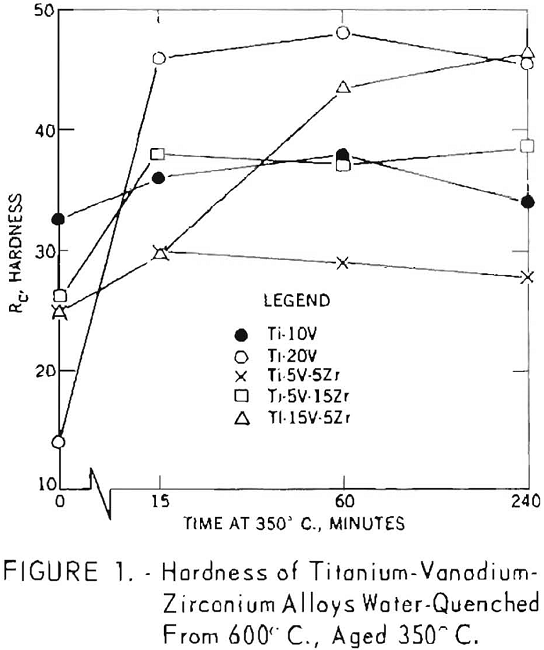


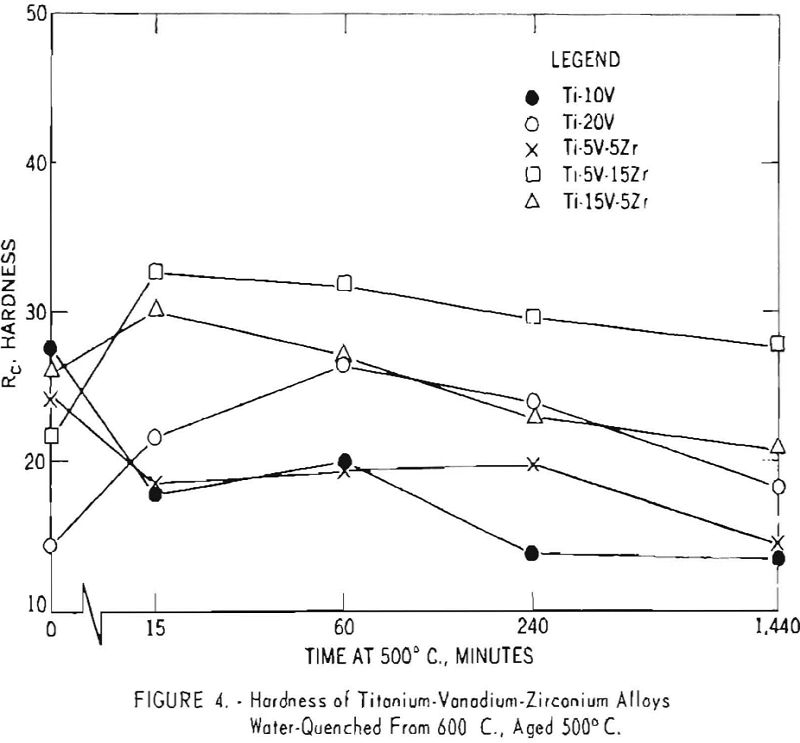
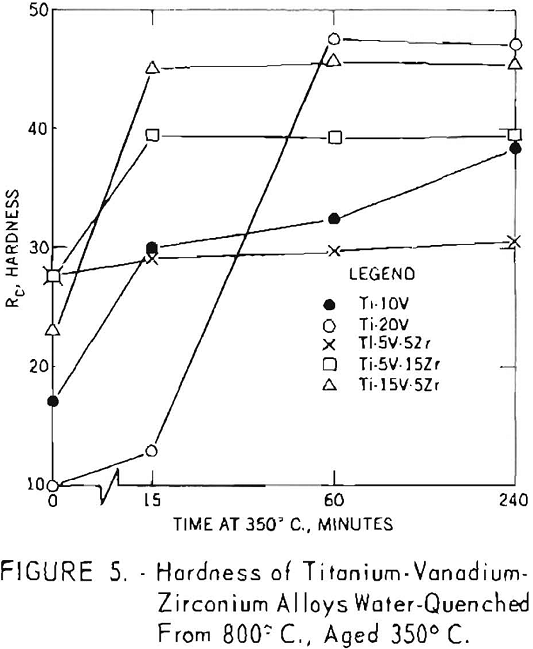

The following data taken from table 3 are illustrative of the room temperature tensile properties of the heat-treated titanium-10vanadium-10zirconium alloy.

Tensile properties of the Ti-10V-10Zr alloy, solution-1reated at 800° C. and then aged 4 hours at 450° C., were:
Ultimate tensile strength…………………………………………p.s.i. 166,000
Yield strength (0.2-percent offset)……………………………p.s.i. 147,500
Elongation in 1 inch……………………………………………percent 3.1
The alloy was brittle in the solution-treated condition having only 5.7 percent elongation.
When the ternary alloys of titanium-vanadium-zirconium studied in this investigation were heat-treated they showed microstructures similar to those of the titanium-vanadium binaries. Single- and two-phase structures were the rule, and no third phase was observed.


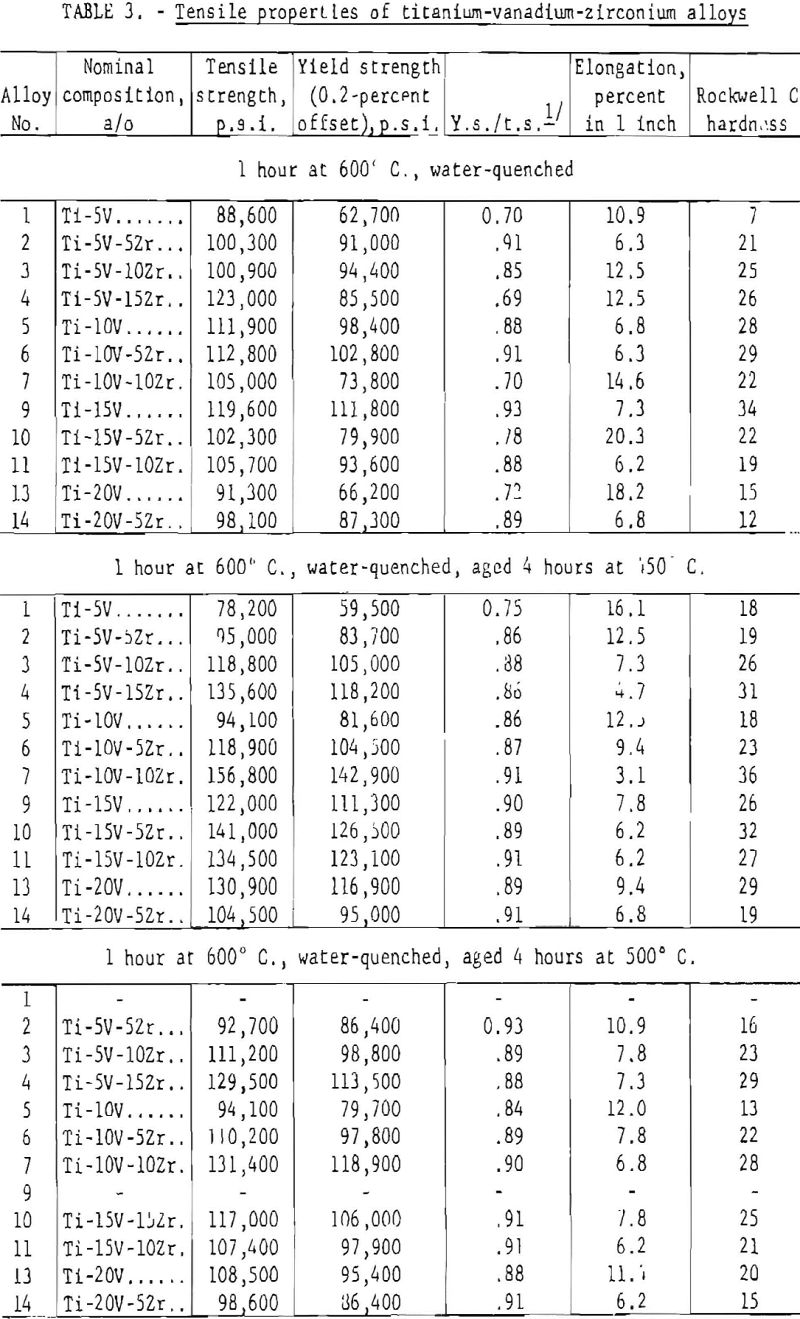
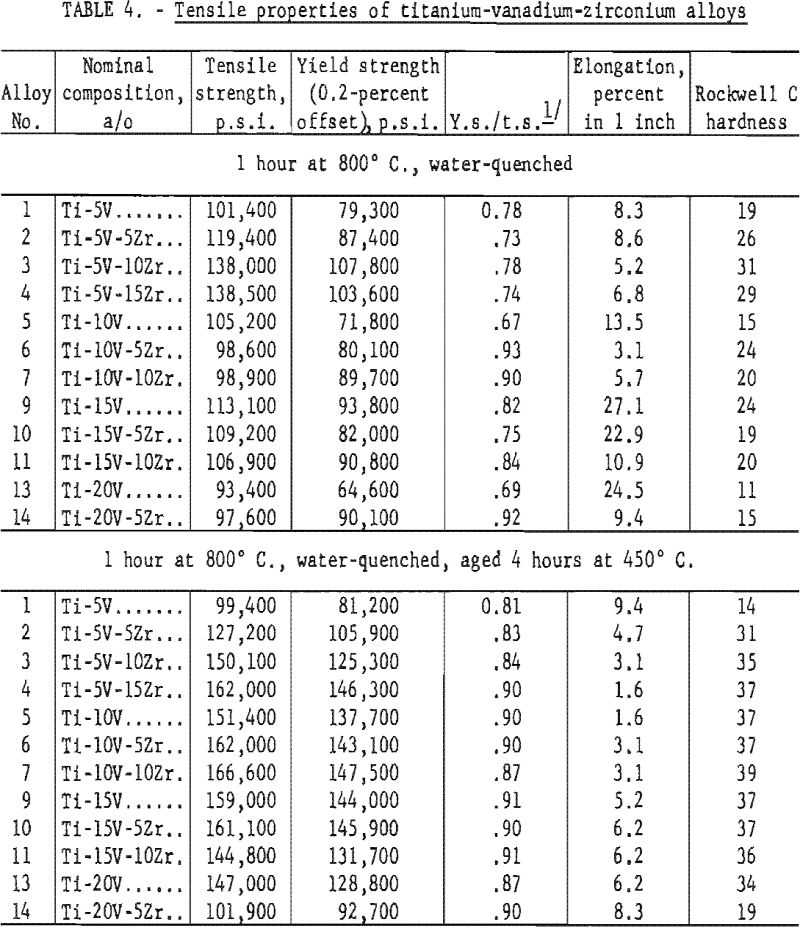
The as-melted structures consisted of transformed beta for compositions in which the vanadium content was less than 15 a/o. At or above 15 a/o, the structures were large beta grains with some alpha prime at the grain boundaries.
Structures obtained in hot rolling at 750° C. consisted of large beta grains with an unresolved alpha precipitate. The alloys containing 15 and 20 a/o vanadium were all beta.
Solution treatment at 600° C. yielded a structure containing a fine precipitate of alpha in large beta grains but otherwise closely resembling the hot-rolled structure.
Aging at either 450° or 500° C. resulted in little visible change in the structure from the solution-treated condition except a quantitative increase in the amount of alpha precipitate.
A martensitic structure resulted from solution treating the titanium- 10vanadium-10zirconium alloy at 800° C. This specimen upon aging, developed far greater strength than the specimens solution-treated at 600° C. However, its structure was associated with poor ductility.
Representative photomicrographs of the titanium-10vanadium-10zirconium alloy, hot-rolled, solution-treated, and age-conditioned are shown in figures 9 through 11.
